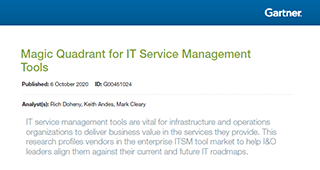At a high level, IT benchmarking provides valuable input into how other businesses are tackling critical initiatives. It can offer a helpful frame of reference and inform your decisions. By benchmarking your IT investments against your peers, you can see if you are over- or under-spending, get a sense for the market, and make the case for or against a particular expenditure. These data points can be especially helpful when researching a new solution, building a business case, and/or justifying a project to your boss.
Our recent report with Forbes Insights, “Delivering Value to Today’s Digital Enterprise: The State of IT Service Management 2017”, includes numerous statistics and definitions that allow you to evaluate the maturity of your business transformation and ITSM efforts, compare your current state to your peers, and identify areas to grow or improve. It’s a great place to start any IT benchmarking initiative, especially one focused on ITSM.
We’ll dig into ITSM-specific benchmarking metrics in future posts, but let’s start with some benchmarks that address your IT organization’s overall position towards transformation and business-oriented value.
Benchmark #1: Attitude toward the pace of IT change and transformation. We asked our respondents, 261 senior-level IT executives around the world, to what extent they saw the pace of IT transformation increasing. Over half, 56 percent, felt that the pace of IT change is accelerating significantly or close to significantly, while 13 percent see IT remaining in the same place it’s already been.
Compare these numbers to attitudes at your organization. Is the rapid pace of IT change widely acknowledged, accepted, and addressed? Or is your IT team characterized more by the proverbial ostrich with its head in the sand? If you’re facing the latter, it may be helpful to see that you’re not alone – 13 percent is a surprisingly high number of executives who don’t feel that the pace of change is increasing. I’d be surprised, however, if the majority is wrong in this case. If you need to prove that IT is changing to support your business case, 56 percent of IT execs are right behind you.
Benchmark #2: Impact and challenges of IT transformation. No matter how quickly you believe it’s happening, it’s indisputable that IT is changing. How is that change impacting IT organizations?

These benchmarks may provide comfort that others face the same issues, give you ideas for managing IT transformation, or help boost your argument for things like additional resources or training opportunities. Fully half of our respondents believe that they need more training and skills development to keep up with today’s pace of IT change. If you provide those opportunities, you’re presumably ahead of 50 percent of the competition. One third of IT leaders are bringing in more third-party expertise. Is that something your organization should consider?
You can also benchmark your team against the challenges that other companies face aligning IT to business services. Do you struggle with the same issues? If not, it proves that you’re doing something right in that department – a strong argument for continued support and investment. If your main challenges are not on this list, why not? If other organizations don’t face the same problems, it may be because of your unique industry or business model – or it may be something that they’ve figured out and you need to address.

Benchmark #3: Focus on maintenance vs. transformation. Some of the most compelling data from our survey came from our questions about maintenance versus transformation. We asked respondents how much of their budget and IT staff time is spent on ongoing maintenance and management activities (like maintaining uptime and availability; applying upgrades, fixes, and patches; and ensuring security) versus new project development or new initiatives – the things that drive transformation and innovation.
The responses varied, but the largest segment for both budget and staff time came in at 26-50 percent; that is, most IT organizations spend between 26-50 percent of their budgets and people resources on maintenance activities. Thirty-seven percent of executives, however, spend the majority of their budget on ongoing maintenance and management, and 32 percent allocate the majority of their IT staff time to “factory” tasks.

This is important data for your IT benchmarking initiative. Every IT organization must balance “keeping the lights on” with driving innovation aimed at business value. These benchmarks provide insight into how well many top organizations are striking that balance – or not, as the case may be. They also demonstrate tremendous opportunity for competitive differentiation. If approximately one third of organizations designate the majority of their time and money to maintenance, they are not prioritizing business transformation. That certainly makes the case that you should.
On the flip side, if you fall into the large percentage of organizations struggling to juggle maintenance and transformation, you know you’re not alone. You can use this benchmarking data to prove that you are not dramatically behind, but that there is a clear imperative to work towards a healthier balance.







